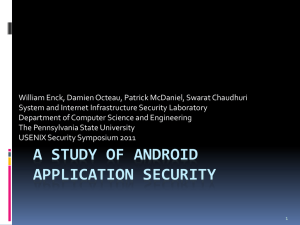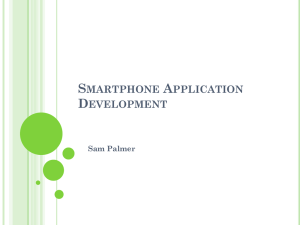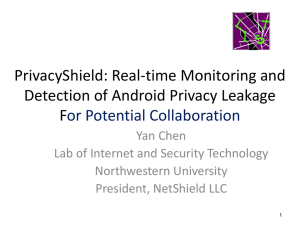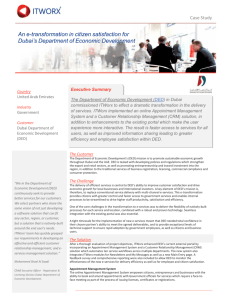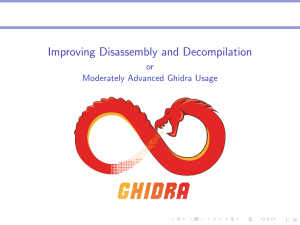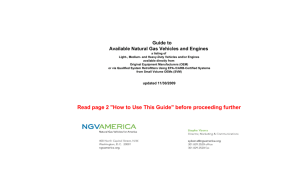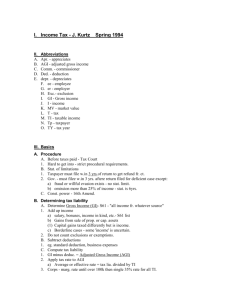ppt
advertisement
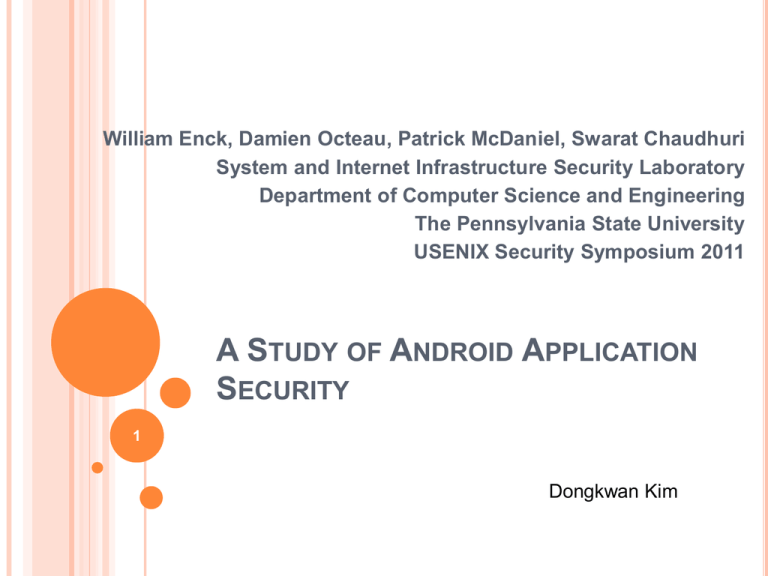
William Enck, Damien Octeau, Patrick McDaniel, Swarat Chaudhuri System and Internet Infrastructure Security Laboratory Department of Computer Science and Engineering The Pennsylvania State University USENIX Security Symposium 2011 A STUDY OF ANDROID APPLICATION SECURITY 1 Dongkwan Kim BOOM! 2 WHAT? Markets are not in a position to provide security in more than a superficial way To broadly characterize the security of applications in the Android Market Contributions ded: A Dalvik decompiler. DVM-to-JVM bytecode retargeting. Analyze 21 million LoC from the top 1100 free applications 3 BACKGROUND Android 4 BACKGROUND Dalvik Virtual Machine JVM => .class DVM => .dex Dalvik dx compiler Constant Pool: -References to other classes -Method names Class Definition: -Numerical constants -Access flags -Class names Data: -Method code -Info related to methods -Variables 5 THE DED DECOMPILER Decompiler from DEX to Java Leverage existing tools for code analysis Require access to source code to identify false-positives resulting from automated code analysis Three stages Retargeting Optimization Decompilation 6 THE DED DECOMPILER 7 THE DED DECOMPILER Optimization and Decompilation Soot as a post-retargeting optimizer Java bytecode generated by ded is legal Source code failure rate is almost entirely due to Soot’s inability 8 THE DED DECOMPILER Source Code Recovery Validations All 1,100 apps decompilation time: 497.7 hours 99.97% of total time -> Soot 9 THE DED DECOMPILER Retargeting Failures 0.59% of classes Unresolved reference Type violations by Android dex compiler ded produces illegal bytecode (rare) Decompilation Failures 5% of classes Soot was able to decompile 94.59% 10 ANALYSIS SPECIFICATION Using Fortify SCA custom rules Control flow analysis Data flow analysis Information leaks, injection attacks Structural analysis Look at API options Grep on steroids Semantic analysis Look at possible variable values 11 ANALYSIS OVERVIEW 12 PHONE IDENTIFIER 246 apps uses phone identifier Only 210 has READ_PHONE_STATE permission 22.4% 19.6% 13 PHONE IDENTIFIER (CONT.) Phone identifiers (ph.#, IMEI, IMSI, etc) sent to network servers, but how are they used? Program analysis pin-pointed 33 apps leaking Phone IDs Finding 2 - device fingerprints Finding 3 – tracking actions Finding 4 – along with registration and login 14 DEVICE FINGERPRINTS 15 TRACKING 16 REGISTRATION AND LOGIN Pros and cons… 17 LOCATION INFORMATION 27.6% 505 applications attempt to access location 304 have the permission. 45.9% 18 LOCATION INFORMATION (CONT.) Found 13 apps with geographic location data flows to the network Many were legitimate: weather, classifieds, points of interest, and social networking services Several instances sent to advertisers (same as TaintDroid). Code recovery error in AdMob library 19 PHONE MISUSE No evidence of abuse in sample set Hard-coded numbers for SMS/voice premium-rate Background audio/video recording Socket API use (not HTTP wrappers) Harvesting list of installed applications 20 AD/ANALYTICS LIBRARIES 51% of the apps included an ad or analytics library (many also included custom functionality) 29% 18.7% 51% 21 AD/ANALYTICS LIBRARIES (CONT.) A few libraries were used most frequently Use of phone id, and location sometimes configura ble by developer 22 PROBING FOR PERMISSIONS (1) 23 PROBING FOR PERMISSIONS (2) 24 DEVELOPER TOOLKITS Some developer toolkits replicate dangerous functio nality Probing for permissions Ex) Android API, catch SecurityException Well-known brands sometimes commission developers that include dangerous functionality. “USA Today” and “FOX News” developed Mercury Intermedia (com/mercuryintermedia), which grabs IMEI on startup 25 CUSTOM EXCEPTIONS 26 INTENT VULNERABILITIES Leaking information to Logs Leaking information via IPC Unprotected bcast receivers Intent injection attacks Delegating control Pending intents are tricky to analyze – get permissions (notification, alarm, and widget APIs) – no vuln found Null checks on IPC input 16 apps had potential vulns 3925 potential null dereferences in 591 apps (53.7%) Sdcard/JNI Use 27 STUDY LIMITATIONS The sample set Code recovery failures Android IPC data flows Fortify SCA language Obfuscation 28 SUMMARY & CONCLUSION ded decompiler Wide misuse of privacy sensitive information Ad and analytic network libraries (51% apps) Failed to securely use Android APIs Potential vulns Found no evidence of telephony misuse Future Directions Code recovery – Fernflower Automated certification App markets need transparency Q? 29 - THANK YOU `
